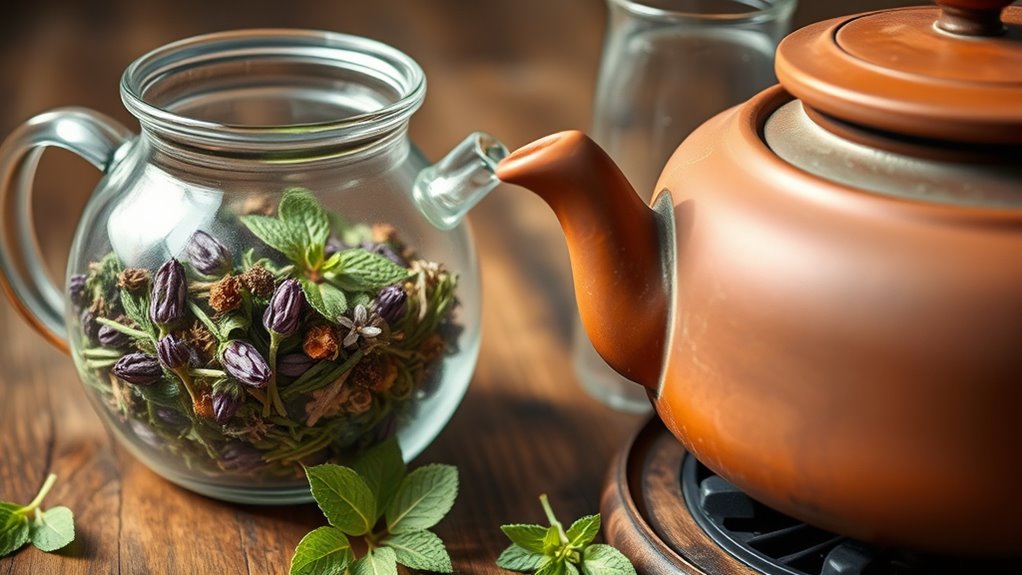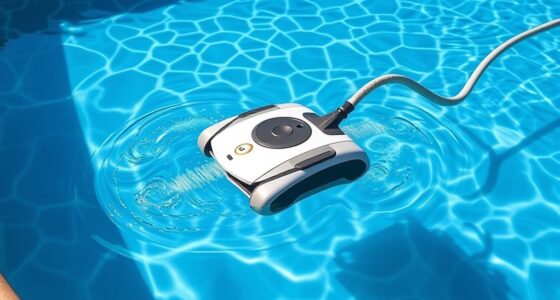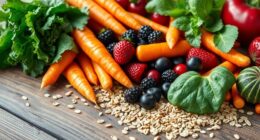Herbal infusions and decoctions differ mainly in preparation: infusions involve steeping delicate herbs like leaves and flowers in hot water for 15-60 minutes, while decoctions require simmering tougher parts like roots or bark for 20-45 minutes. Use the right equipment, like pots and strainers, and follow specific steps for each method. Properly stored, your herbal brews will stay potent longer. Keep exploring for detailed tips on making the perfect infusion or decoction.
Key Takeaways
- Infusions involve steeping delicate herbs in hot water for 15 minutes to several hours, while decoctions require simmering tougher parts for 20-45 minutes.
- Use gentle heat and short steeping times for infusions; simmer denser plant parts slowly for decoctions.
- For hot infusions, pour boiling water over herbs; for cold infusions, steep herbs in cold water in the refrigerator.
- Strain decoctions after simmering and store in airtight containers in the fridge, using within a few days.
- Enhance brews with natural sweeteners, spices, or flavorings, and store properly to maximize their medicinal and sensory benefits.
Understanding the Differences Between Infusions and Decoctions
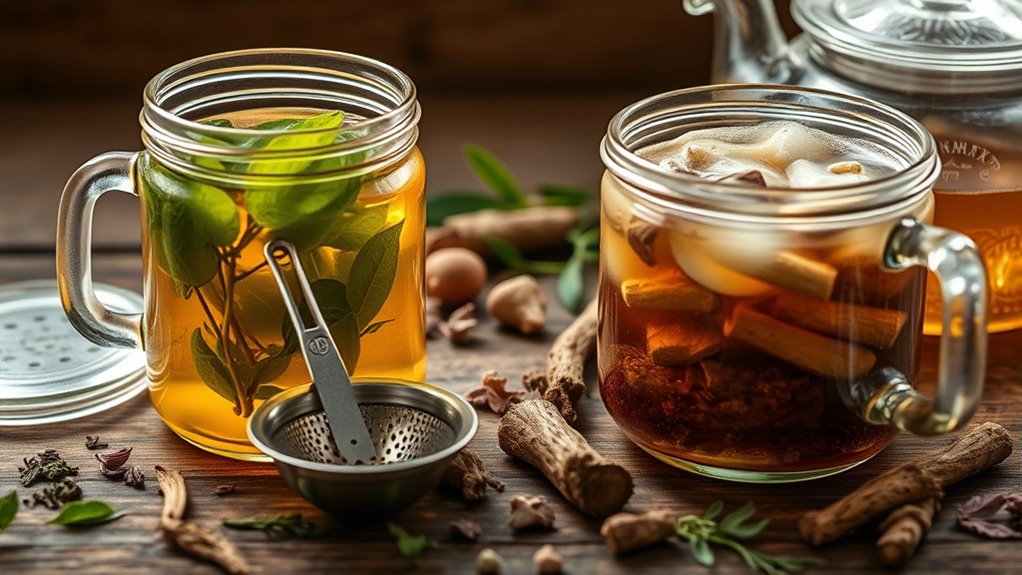
Understanding the differences between infusions and decoctions is essential for preparing herbal remedies effectively. Both are methods of water extraction used in herbal preparations, but they target different plant parts and yield distinct results. Infusions involve steeping delicate plant parts like leaves and flowers in hot water for 20 minutes to several hours, gently extracting water-soluble phytochemicals. Decoctions, on the other hand, require simmering tougher plant parts such as roots, barks, berries, and seeds for 20-45 minutes to break down cell walls and extract active compounds. The main difference lies in preparation: infusions use minimal heat and quick steeping, while decoctions involve prolonged simmering. Choosing the right method depends on the plant part and the strength of extract desired. Additionally, regional practices influence how these techniques are applied, ensuring optimal extraction based on traditional knowledge. Furthermore, understanding herbal extraction techniques can help in maximizing the therapeutic benefits of herbal remedies. For example, the temperature of water used during extraction plays a crucial role in determining the potency and efficacy of the final infusion or decoction.
Selecting the Right Herbs for Your Brew
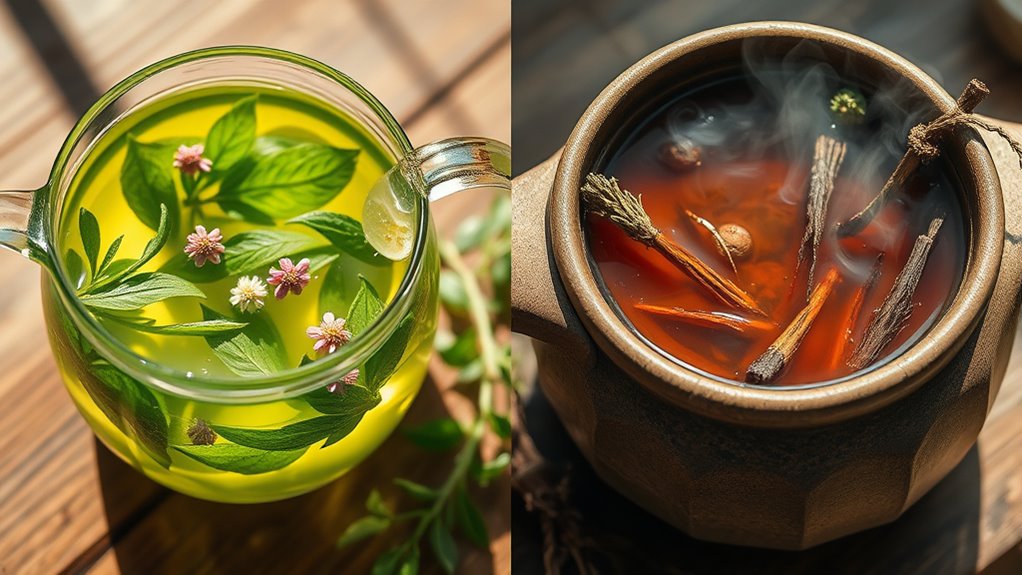
Choosing the right herbs for your brew depends on their physical structure and chemical makeup. Delicate herbs like flowers, leaves, and aromatic roots such as ginger and holy basil are best suited for infusions, as they release volatile oils and vitamins without heat. Roots and barks, including ginger, turmeric, and elderberry, are dense and woody, making them ideal for decoctions to extract medicinal compounds thoroughly. Fragile herbs like marshmallow root, lemon balm, and peppermint are perfect for cold infusions, preserving delicate herbal constituents. Use fresh herbs when possible for maximum flavor and nutrients, but dried herbs are more concentrated. Consider the herb’s chemical constituents—water-soluble compounds like flavonoids and polysaccharides favor infusions, while others may need tinctures. Herbal extraction methods vary depending on these factors to optimize health benefits, and understanding the herb’s physical structure can significantly influence the brewing method chosen. Additionally, awareness of the herb’s chemical makeup can help tailor the extraction process for specific therapeutic effects. Recognizing the herbal preparation technique suitable for each herb ensures maximum potency and efficacy in your brews. Proper knowledge of personal preferences and intended effects can further refine your herbal brewing process for personalized health benefits.
Equipment and Preparations Needed for Herbal Water Extractions
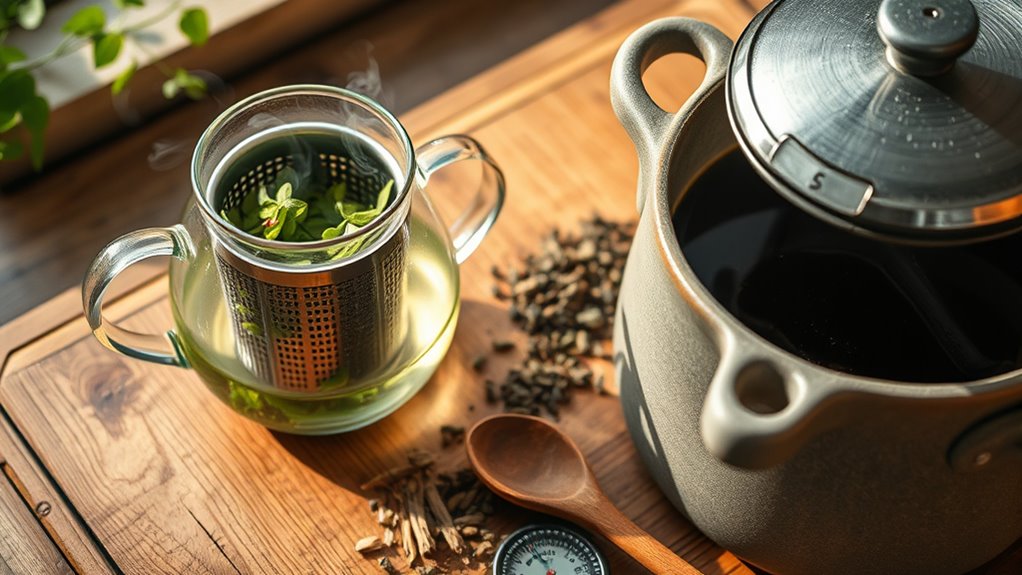
To guarantee your herbal infusions and decoctions turn out their best, you need the right equipment and proper preparation. Start with a stainless steel or glass pot with a lid, essential for maintaining purity and heat control. Use a fine-mesh strainer or cheesecloth to strain your herbs easily, ensuring a smooth drink. Selecting a pot with a high-quality build can help maintain consistent temperatures and prevent contamination. Choose high-quality, organic herbs, and measure them accurately—about 1 teaspoon dried herbs per cup for infusions or 3 tablespoons per quart for decoctions. For cold infusions, steep herbs in a jar with cold water in the refrigerator for 8-12 hours, while hot infusions require pouring boiling water over herbs and steeping for 15 minutes to an hour. Proper herb selection is crucial to maximize flavor and medicinal benefits. Using the correct watering system in self watering plant pots can help ensure your herbs receive consistent moisture, which is essential for optimal growth. Maintaining optimal air quality around your herbs can also enhance their growth and potency. Additionally, paying attention to contamination prevention by thoroughly cleaning utensils is vital to ensure the purity of your herbal extracts. Clean all utensils thoroughly to prevent contamination, and store your finished herbal water in airtight containers, consuming within a week.
Step-by-Step Guide to Making Hot and Cold Infusions
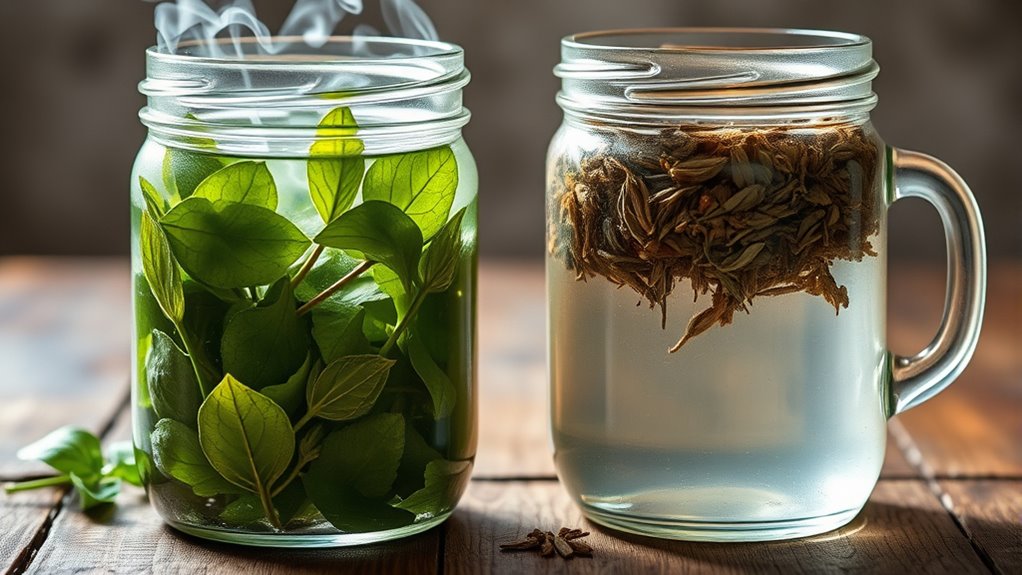
Making herbal infusions is straightforward once you know the steps. For a hot herbal tea, place 1 to 3 tablespoons of dried herbs into a mug or teapot, pour just-boiled water over them, cover, and steep for 15 minutes to an hour, depending on your desired strength. Using an airless paint sprayer as an analogy, think of the herbs as the paint and the water as the spray; the process extracts flavors efficiently, much like how high pressure delivers paint evenly. This method ensures you maximize the nutrient extraction from your herbs, enhancing their health benefits. Additionally, incorporating herbal medicinal properties can boost your immune support and overall wellness during survival situations. To further improve your infusion process, understanding the benefits of proper steeping times can help you tailor each brew for optimal flavor and potency. Recognizing the importance of temperature control can also influence the effectiveness of your infusions, as certain herbs release their compounds better at specific temperatures.
For cold infusions, put a bundle of herbs like peppermint or lemon balm into a jar, cover with cold or room temperature water, and refrigerate for 8 to 12 hours to gently extract flavors and nutrients. Allowing the herbs to steep slowly in cold water preserves delicate compounds and flavors that might be lost with heat.
- Visualize herbs floating in water, releasing their aroma
- Imagine the steam rising as you steep hot infusions
- Picture herbs slowly soaking in the fridge for cold infusions
How to Prepare a Traditional Decoction
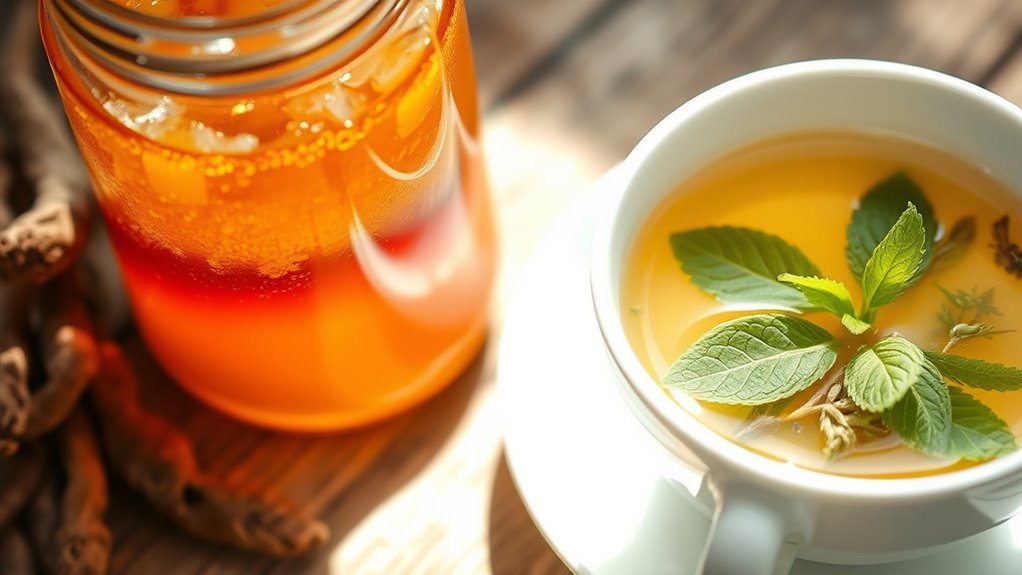
Start by selecting herbs that suit your needs and measure 1 to 3 teaspoons per 8 ounces of water. Bring the water and herbs to a boil, then reduce the heat and simmer gently for 20 to 40 minutes. Once done, strain out the herbs and store the decoction in the fridge, ready to use within a few days. Be sure to monitor the potency of your decoction to ensure safety and effectiveness. Additionally, paying attention to storage options can help maintain the quality of your herbal infusion. Regularly checking your decoction for changes in scent or appearance can serve as indicators of spoilage, ensuring you use fresh and safe preparations. Proper herb selection is crucial for a successful decoction.
Choosing Suitable Herbs
Have you ever wondered which herbs are best suited for a traditional decoction? When selecting herbs, focus on dense, woody, or hard plant parts like roots, barks, seeds, berries, and mushrooms. These parts require prolonged simmering to release their medicinal properties effectively.
Visualize:
- Roots and barks, dark and fibrous, releasing deep, potent flavors
- Seeds and berries, bursting with concentrated medicinal compounds
- Mushrooms, firm and dense, rich in bioactive substances
Use about 1-3 teaspoons of dried herbs per 8 ounces of water, adjusting for fresh herbs or desired potency. Place the herbs in cold water, cover, and simmer gently for 20-40 minutes.
This slow process guarantees maximum extraction of medicinal properties, creating a potent decoction.
Proper Simmering Techniques
To prepare a proper decoction, focus on maintaining the right simmering technique. Use a stainless steel or heat-safe glass pot with a lid to prevent heat loss and keep volatile compounds intact.
Measure 1 to 3 teaspoons of dried herbs per 8 ounces of water, adjusting based on herb density and desired strength.
Bring the mixture to a gentle boil, then reduce to a low simmer, keeping a steady temperature to ensure proper extraction of active compounds.
Simmer for 20 to 45 minutes, depending on whether you’re using roots or barks that need longer brewing.
Make sure the water level stays adequate during simmering.
Once done, turn off the heat, let it cool slightly with the lid on to preserve oils, then strain and store appropriately.
Straining and Storage
Once you’ve finished simmering your herbs, the next step is to strain the decoction to remove all plant material. Use a fine-mesh sieve or cheesecloth to catch tiny particles and guarantee a smooth liquid. Incorporating a proper storage method can further extend the shelf life and potency of your decoction. After straining, transfer the clear decoction into a clean glass jar or bottle, making sure it’s sealed tightly. Store it in the refrigerator to keep it fresh and prevent spoilage. When storing, consider dividing the decoction into smaller portions for easy reheating later. Remember to label the container with the date to track its freshness. Discard any decoction that develops an off smell or mold. Proper straining and storage help preserve the decoction’s potency and safety, ensuring you get the most benefit from your herbal brew.
Tips for Enhancing and Using Your Herbal Brews
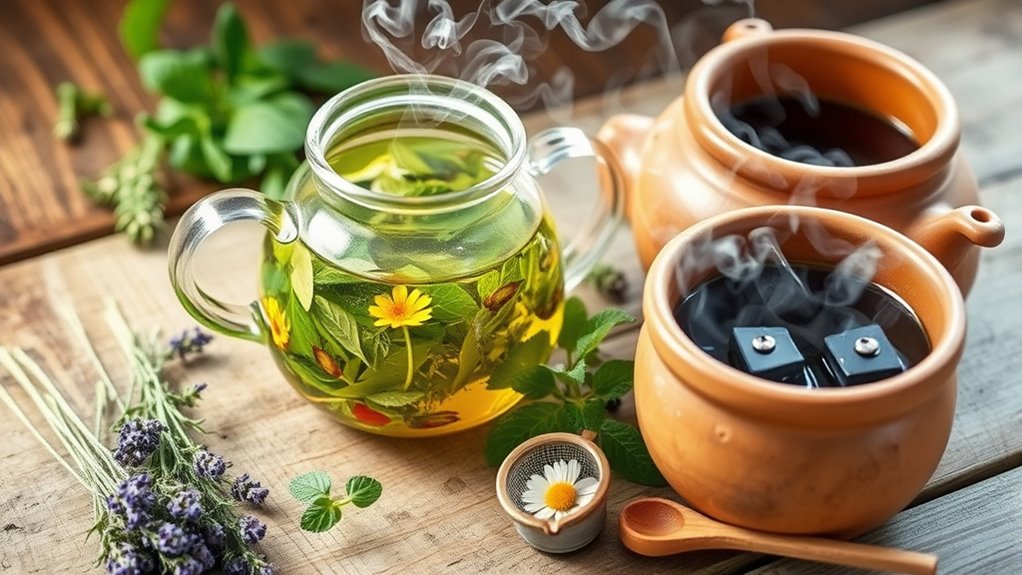
To make your herbal brews more enjoyable and effective, try adding natural sweeteners like honey or stevia, which improve taste and absorption. Experiment with ingredients like lemon, ginger, or cinnamon to boost flavor and health benefits. Adjust steeping times and simmering to enhance potency without extracting bitterness. Be mindful of fire safety when preparing and storing your herbal infusions to prevent accidents or hazards. Incorporating proper raw food handling techniques can also ensure the safety and freshness of your herbal brews. Additionally, understanding AI security principles can help you safeguard your herbal preparations when using smart kitchen devices.
Flavor Enhancement Techniques
Enhancing the flavor of herbal infusions and decoctions can turn a simple brew into a delightful experience. You can boost your herbal infusion’s flavor by adding natural sweeteners like honey, stevia, or maple syrup, which mask bitterness and add richness. Incorporate spices such as cinnamon, ginger, or cardamom during brewing to introduce warmth and complexity.
Using fresh herbs instead of dried ones intensifies aroma and flavor, making your brew more vibrant. A splash of citrus juice, like lemon or orange, brightens flavors and makes the infusion more palatable.
To create an inviting sensory experience, consider:
- Drizzling honey over the finished brew
- Simmering herbs with warming spices
- Adding a squeeze of fresh citrus before serving
Creative Usage Ideas
Creative ways to use your herbal infusions and decoctions can turn everyday drinks into health-boosting treats and versatile remedies. Enhance your infusions by adding natural sweeteners like honey, stevia, or fruit juice to boost flavor and medicinal absorption.
Use decoctions as bases for syrups, tinctures, or herbal liqueurs to create multi-purpose remedies and culinary ingredients. Incorporate cooled infusions into your skincare routine by adding them to baths, facial steams, or homemade lotions for added skin benefits.
For convenience, freeze herbal infusions or decoctions in ice cube trays to make herbal popsicles or easily add medicinal herbs to smoothies and beverages. Mixing different infusions or decoctions allows you to craft personalized tonics tailored to specific health goals or taste preferences, expanding your creative usage of herbal remedies.
Safely Storing and Dosaging Your Herbal Extracts
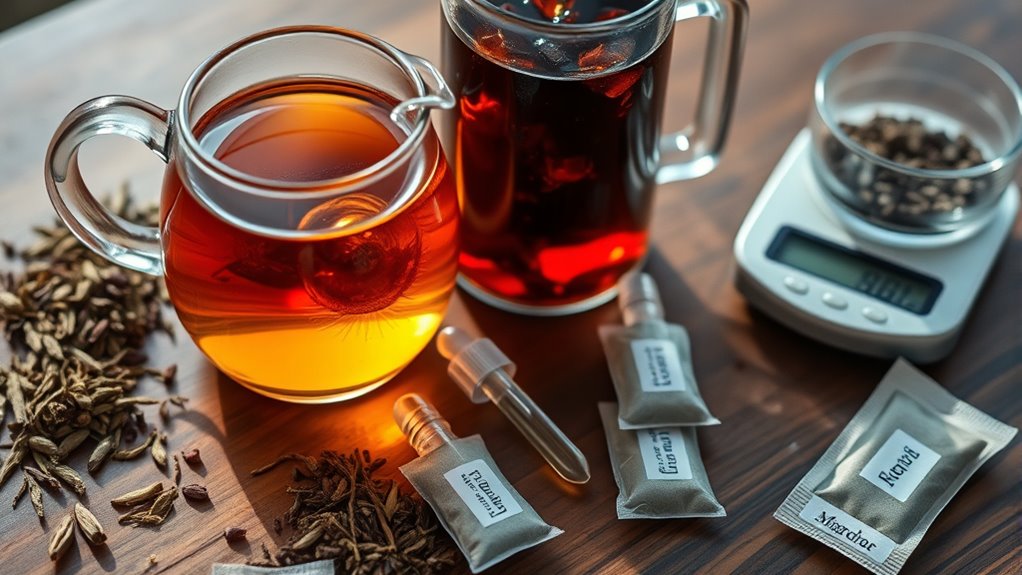
Proper storage and accurate dosing are essential to maximize the safety and effectiveness of your herbal extracts. When storing herbal infusions, always use airtight glass containers in the refrigerator and consume within 5 to 7 days to maintain freshness and prevent spoilage.
Use clean, dry utensils and strainers during preparation to avoid contamination, and label each container with the preparation date to monitor potency. For added safety, especially with cold infusions, ensure herbs and water are thoroughly cleaned and stored in sterilized jars.
When dosing, remember that the strength of your extract and individual needs matter. Typically, 1-4 cups daily are recommended, but always consult a healthcare provider for personalized guidance.
Keep your herbal infusions safe, fresh, and effective.
Frequently Asked Questions
How Do You Prepare Herbal Infusions?
To prepare herbal infusions, you start by placing 1 to 2 tablespoons of dried herbs or 2 to 4 tablespoons of fresh herbs into a heatproof container or teapot.
Pour boiling water over the herbs, ensuring they’re fully submerged.
Cover and steep for 15 minutes to an hour, then strain out the herbs.
You can enjoy it immediately or store it in the fridge for a few days.
What Is the Difference Between Herbal Decoction and Infusion?
You want to know the difference between herbal decoctions and infusions. An infusion involves steeping delicate herbs like leaves and flowers in hot or cold water for a short time, producing a light, aromatic drink.
A decoction, on the other hand, requires simmering tougher plant parts such as roots or bark for longer, resulting in a concentrated, potent extract.
Both methods extract different compounds suited for various herbal uses.
How Do You Make an Herbal Decoction?
To make an herbal decoction, measure 1-3 teaspoons of dried herbs or 1-2 tablespoons of fresh herbs for each 8 ounces of water.
Place the herbs in a saucepan, add cold water, and bring to a gentle boil with the lid on.
Reduce heat and simmer for 20-40 minutes.
Strain, let cool slightly, then store in the fridge and consume within 3-4 days for best freshness.
What Is the Ratio of Herbs to Water for Decoction?
Did you know that a typical decoction uses about 1 to 3 teaspoons of dried herbs per 8 ounces of water?
You should adjust this based on herb density, doubling the amount for fresh herbs.
For denser roots or barks, you might use up to 1 tablespoon.
Scale ratios for larger batches, like a quarter cup per quart, to make multiple servings while maintaining the desired strength.
Conclusion
Now that you know the secrets of herbal infusions and decoctions, you’re practically a brewing wizard! With just a little practice, you’ll craft potions so powerful, they could heal kingdoms—or at least make your tea time legendary. Imagine sipping on elixirs that boost your energy or soothe your soul, all from your own kitchen. Get brewing, experiment wildly, and turn every cup into an epic adventure in herbal mastery!
